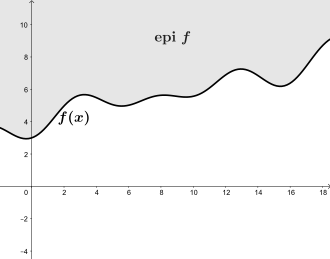Epigraph (mathematics)
 From Wikipedia the free encyclopedia
From Wikipedia the free encyclopedia


In mathematics, the epigraph or supergraph[1] of a function valued in the extended real numbers is the set
Importantly, unlike the graph of the epigraph always consists entirely of points in (this is true of the graph only when is real-valued). If the function takes as a value then will not be a subset of its epigraph For example, if then the point will belong to but not to These two sets are nevertheless closely related because the graph can always be reconstructed from the epigraph, and vice versa.
The study of continuous real-valued functions in real analysis has traditionally been closely associated with the study of their graphs, which are sets that provide geometric information (and intuition) about these functions.[2] Epigraphs serve this same purpose in the fields of convex analysis and variational analysis, in which the primary focus is on convex functions valued in instead of continuous functions valued in a vector space (such as or ).[2] This is because in general, for such functions, geometric intuition is more readily obtained from a function's epigraph than from its graph.[2] Similarly to how graphs are used in real analysis, the epigraph can often be used to give geometrical interpretations of a convex function's properties, to help formulate or prove hypotheses, or to aid in constructing counterexamples.
Definition[edit]
The definition of the epigraph was inspired by that of the graph of a function, where the graph of is defined to be the set
The epigraph or supergraph of a function valued in the extended real numbers is the set[2]
In the union over that appears above on the right hand side of the last line, the set may be interpreted as being a "vertical ray" consisting of and all points in "directly above" it. Similarly, the set of points on or below the graph of a function is its hypograph.
The strict epigraph is the epigraph with the graph removed:
Relationships with other sets[edit]
Despite the fact that might take one (or both) of as a value (in which case its graph would not be a subset of ), the epigraph of is nevertheless defined to be a subset of rather than of This is intentional because when is a vector space then so is but is never a vector space[2] (since the extended real number line is not a vector space). This deficiency in remains even if instead of being a vector space, is merely a non-empty subset of some vector space. The epigraph being a subset of a vector space allows for tools related to real analysis and functional analysis (and other fields) to be more readily applied.
The domain (rather than the codomain) of the function is not particularly important for this definition; it can be any linear space[1] or even an arbitrary set[3] instead of .
The strict epigraph and the graph are always disjoint.
The epigraph of a function is related to its graph and strict epigraph by
Reconstructing functions from epigraphs[edit]
The epigraph is empty if and only if the function is identically equal to infinity.
Just as any function can be reconstructed from its graph, so too can any extended real-valued function on be reconstructed from its epigraph (even when takes on as a value). Given the value can be reconstructed from the intersection of with the "vertical line" passing through as follows:
- case 1: if and only if
- case 2: if and only if
- case 3: otherwise, is necessarily of the form from which the value of can be obtained by taking the infimum of the interval.
The above observations can be combined to give a single formula for in terms of Specifically, for any
Relationships between properties of functions and their epigraphs[edit]
A function is convex if and only if its epigraph is a convex set. The epigraph of a real affine function is a halfspace in
A function is lower semicontinuous if and only if its epigraph is closed.
See also[edit]
- Effective domain
- Hypograph (mathematics) – Mathematical analysis term
- Proper convex function
Citations[edit]
- ^ a b Pekka Neittaanmäki; Sergey R. Repin (2004). Reliable Methods for Computer Simulation: Error Control and Posteriori Estimates. Elsevier. p. 81. ISBN 978-0-08-054050-4.
- ^ a b c d e f Rockafellar & Wets 2009, pp. 1–37.
- ^ Charalambos D. Aliprantis; Kim C. Border (2007). Infinite Dimensional Analysis: A Hitchhiker's Guide (3rd ed.). Springer Science & Business Media. p. 8. ISBN 978-3-540-32696-0.
References[edit]
- Rockafellar, R. Tyrrell; Wets, Roger J.-B. (26 June 2009). Variational Analysis. Grundlehren der mathematischen Wissenschaften. Vol. 317. Berlin New York: Springer Science & Business Media. ISBN 9783642024313. OCLC 883392544.
- Rockafellar, Ralph Tyrell (1996), Convex Analysis, Princeton University Press, Princeton, NJ. ISBN 0-691-01586-4.
![{\displaystyle f:X\to [-\infty ,\infty ]}](https://wikimedia.org/api/rest_v1/media/math/render/svg/cb5b80b60f448c0542dc59fd71f22b8ce01e8bc7)
![{\displaystyle [-\infty ,\infty ]=\mathbb {R} \cup \{\pm \infty \}}](https://wikimedia.org/api/rest_v1/media/math/render/svg/f784980f597dae36b4d32c2a89de0a449e99aca8)










![{\displaystyle [-\infty ,\infty ]}](https://wikimedia.org/api/rest_v1/media/math/render/svg/e13233867b861889693a36843d98e51d90d38f9f)




![{\displaystyle {\begin{alignedat}{4}\operatorname {epi} f&=\{(x,r)\in X\times \mathbb {R} ~:~r\geq f(x)\}\\&=\left[f^{-1}(-\infty )\times \mathbb {R} \right]\cup \bigcup _{x\in f^{-1}(\mathbb {R} )}(\{x\}\times [f(x),\infty ))\end{alignedat}}}](https://wikimedia.org/api/rest_v1/media/math/render/svg/120ec1dd255652a541267c9f9e14772d73a5fa48)




![{\displaystyle X\times [-\infty ,\infty ].}](https://wikimedia.org/api/rest_v1/media/math/render/svg/e7239088e616ca5dda3b85293effcd1c4591692c)

![{\displaystyle X\times [-\infty ,\infty ]}](https://wikimedia.org/api/rest_v1/media/math/render/svg/a4a86078b26dc461988a176fa16b3643c870419b)


![{\displaystyle \operatorname {epi} f=\left[\operatorname {epi} _{S}f\,\cup \,\operatorname {graph} f\right]\,\cap \,[X\times \mathbb {R} ]}](https://wikimedia.org/api/rest_v1/media/math/render/svg/7252e51d8139b3f5d544bd4bb63fb06855c37db9)

















